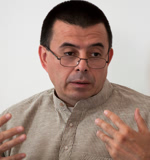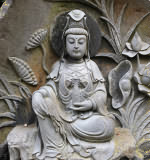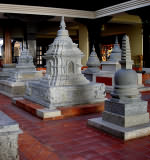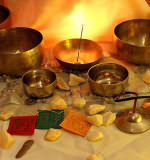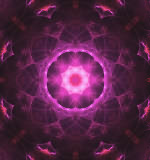| Töltsd le és telepítsd a nélkülözhetetlen betűtípusokat(s) Hogy megtekinthesd a Szanszkritot annak teljes fényében Olvass Transzliteráció (2) (magyar) hogy teljes mértékben átlásd a transzliterációs rendszert |
Tanulj Szanszkritul - Szanszkrit idézetek 1
Jól ismert Szanszkrit idézetek - 1. rész
Introduction
Hi, this is Gabriel Pradīpaka. This is the first document of Sanskrit quotes. I conceived of this document as one of practice. You will be able to read Sanskrit quotes by different authors. Although it is true that I am going to show lots of quotes excerpted from scriptures of Trika or Non-dual Shaivism of Kashmir (the philosophical system I teach), there will be quotes of other traditions too. I wish you use this document to practice Sanskrit completely. You may practice how to write in Devanāgarī as well as Declension, Conjugation of Verbs, etc. As I explain all those subjects to you, I will use these quotes, no doubt about it.
Besides the Sanskrit practice, there are plenty of teachings contained in the quotes themselves. So, it is a great chance for you to learn a little more about this immense culture. The Sanskrit literature is really huge. In fact, no other literature is a match for it as far as "size" is concerned, in every sense of the word. Thus, you are lucky indeed because you will be able to enjoy and enjoy Sanskrit endlessly. Your lifetime is not enough to finish reading all that is written in Sanskrit, so your joy will never finish either.
Important: All that is in brackets and italicized within the translation has been added by me in order to complete the sense of a particular phrase or sentence. In turn, all that is between double hyphen (--...--) constitutes clarifying further information also added by me.
The sage Vasugupta discovers the Śivasūtra-s
According to the sage Kṣemarāja (tenth century A.D.), this is the real story of the Śivasūtra-s' discovery. This sacred scripture is the foremost one in Trika or Non-dual Shaivism of Kashmir.
इह कश्चिच्छक्तिपातवशोन्मिषन्माहेश्वरभक्त्यतिशयादनङ्गीकृताधरदर्शनस्थनागबोध्यादिसिद्धादेशनः शिवाराधनपरः पारमेश्वरनानायोगिनीसिद्धसत्सम्प्रदायपवित्रितहृदयः श्रीमहादेवगिरौ महामाहेश्वरः श्रीमान् वसुगुप्तनामा गुरुरभवत्। कदाचिच्चासौ द्वैतदर्शनाधिवासितप्राये जीवलोके रहस्यसम्प्रदायो मा विच्चेदीत्याशयतोऽनुजिघृक्षापरेण परमशिवेन स्वप्नेऽनुग्रह्योन्मिषितप्रतिभः कृतो यथात्र महीभृति महति शिलातले रहस्यमस्ति तदधिगम्यानुग्रहयोग्येषु प्रकाशयेति। प्रबुद्धश्चासावन्विष्यंस्तां महतीं शिलां करस्पर्शनमात्रपरिवर्तनतः संवादीकृतस्वप्नां प्रत्यक्षीकृत्येमानि शिवोपनिषत्सङ्ग्रहरूपाणि शिवसूत्राणि ततः समाससाद। एतानि च सम्यगधिगम्य भट्टश्रीकल्लटाद्येषु सच्छिष्येषु प्रकाशितवान् स्पन्दकारिकाभिश्च सङ्गृहीतवान्। तत्पारम्पर्यप्राप्तानि स्पन्दसूत्राण्यस्माभिः स्पन्दनिर्णये सम्यग्निर्णीतानि। शिवसूत्राणि तु निर्णीयन्ते॥
तत्र प्रथमं नरेश्वरभेदवादिप्रातिपक्ष्येण चैतन्यपरमार्थतः शिव एव विश्वस्यात्मेत्यादिशति-
Iha kaścicchaktipātavaśonmiṣanmāheśvarabhaktyatiśayādanaṅgīkṛtādharadarśanasthanāgabodhyādisiddhādeśanaḥ śivārādhanaparaḥ pārameśvaranānāyoginīsiddhasatsampradāyapavitritahṛdayaḥ śrīmahādevagirau mahāmāheśvaraḥ śrīmān vasuguptanāmā gururabhavat| Kadāciccāsau dvaitadarśanādhivāsitaprāye jīvaloke rahasyasampradāyo mā viccedītyāśayato'nujighṛkṣāpareṇa paramaśivena svapne'nugrahyonmiṣitapratibhaḥ kṛto yathātra mahībhṛti mahati śilātale rahasyamasti tadadhigamyānugrahayogyeṣu prakāśayeti| Prabuddhaścāsāvanviṣyaṁstāṁ mahatīṁ śilāṁ karasparśanamātraparivartanataḥ saṁvādīkṛtasvapnāṁ pratyakṣīkṛtyemāni śivopaniṣatsaṅgraharūpāṇi śivasūtrāṇi tataḥ samāsasāda| Etāni ca samyagadhigamya bhaṭṭaśrīkallaṭādyeṣu sacchiṣyeṣu prakāśitavān spandakārikābhiśca saṅgṛhītavān| Tatpāramparyaprāptāni spandasūtrāṇyasmābhiḥ spandanirṇaye samyagnirṇītāni| Śivasūtrāṇi tu nirṇīyante||
Tatra prathamaṁ nareśvarabhedavādiprātipakṣyeṇa caitanyaparamārthataḥ śiva eva viśvasyātmetyādiśati-
In this world (iha), on the sacred (śrī) mountain (girau) Mahādeva (mahādeva), someone (kaścid) worthy of reverence (śrīmān) (lived). His heart (hṛdayaḥ) had been purified (pavitrita) by the Noble (sat) Tradition (sampradāya) of the various (nānā) Self-realized Beings (siddha) and Yoginī-s (yoginī) pertaining to the Supreme Lord (pārameśvara). He was devoted (paraḥ) to the worship (ārādhana) of the Auspicious One (śiva). Owing to excess (atiśayāt) of devotion (bhakti) to the Great Lord (māheśvara), which (devotion) shone forth (in him) (unmiṣat) by (vaśa) the Descent (pāta) of Power (śakti) --i.e. Divine Grace--, gave a teaching (ādeśanaḥ) that did not agree (anaṅgīkṛta) with that of such Self-realized Beings (in Buddhism) (siddha) as Nāgabodhi (nāgabodhi) and the rest (ādi), which were occupied (stha) with lower (adhara) viewpoints (darśana). He was (abhavat) a great devotee of the Lord (mahāmāheśvaraḥ) and a Guru (guruḥ). His name (nāmā): Vasugupta (vasugupta).
And (ca) once upon a time (kadācid), the Supreme (parama) Śiva (śivena), disposed (pareṇa) to grant Favor (anujighṛkṣā) and with the intention (iti-āśayataḥ) that: "Let the Secret (rahasya) Tradition (sampradāyaḥ) not (mā) be interrupted (vicchedi) in this world (loke) of the living beings (jīva) which is mostly (prāye) perfumed (adhivāsita) with the dualistic (dvaita) viewpoint (darśana)!"; expanded (unmiṣita... kṛtaḥ) in dream (svapne) the consciousness (pratibhaḥ) of that (Vasugupta) (asau) by bestowing Divine Grace on him (anugrahya). (He said to him) so (yathā... iti):
"Here (atra), on this mountain (mahībhṛti), there is (asti) the Secret Esoteric Teaching (rahasyam) under (tale) a big (mahati) stone (śilā). Having obtained it (tat adhigamya), reveal it (prakāśaya) to those who are fit (yogyeṣu) for receiving Divine Grace (anugraha)".
Having awakened (prabuddhaḥ ca), he --i.e. Vasugupta-- (asau) started to search about (anviṣyan) that (tām) big (mahatīm) stone (śilām). (And having found it,) he turned it round (parivartanataḥ) by a mere (mātra) touch (sparśana) of the hand (kara), seeing with his own eyes (pratyakṣīkṛtya) the dream (svapnām) confirmed (saṁvādīkṛta). He thus (tatas) obtained (samāsasāda) these (imāni) Aphorisms (sūtrāṇi) of Śiva (śiva), which (rūpāṇi) are a compendium (saṅgraha) of the Esoteric Doctrine (upaniṣad) of Śiva (śiva).
And (ca), having completely (samyak) studied them (etāni... adhigamya), he revealed them (etāni... prakāśitavān) to (such) noble (sad) disciples (śiṣyeṣu) (as) most venerable (bhaṭṭaśrī) Kallaṭa (kallaṭa) and others (ādyeṣu), and (ca) collected them (etāni... saṅgṛhītavān) in the form of Spandakārikā-s (spandakārikābhiḥ). The aphorisms (sūtrāṇi) dealing with the Primordial Vibration (spanda) --i.e. Spandakārikā-s or Spandasūtra-s--, obtained (prāptāni) from that (tad) uninterrupted discipular succession (panorama), have been totally (samyak) ascertained (nirṇītāni) by us (asmābhiḥ) in Spandanirṇaya (spandanirṇaye). And now (tu), the Śivasūtra-s (śivasūtrāṇi) are being ascertained (nirṇīyante).
In them --i.e. in the Śivasūtra-s-- (tatra), it is firstly (prathamam) taught (ādiśati), in complete opposition (prātipakṣyeṇa) to those following the doctrine (vādi) of difference (bheda) between man (nara) and the Lord (īśvara), that "Śiva (śivaḥ) alone (eva), in the highest sense (paramārthatas) of (the word) Consciousness (caitanya), (is) the Self (ātmā) of the universe (viśvasya... iti)".—
The sage Patañjali gives the meaning of Concentration
According to the sage Patañjali, this is what the true Concentration is:
देशबन्धश्चित्तस्य धारणा॥१॥
Deśabandhaścittasya dhāraṇā||1||
Concentration (dhāraṇā) is the mind's (cittasya) fixation (bandhaḥ) on one point (deśa)||1||
(Yogasūtra-s of Patañjali, 1st aphorism, Third Section)
Svacchandatantra gives the meaning of Śakti
The ancient sacred scripture known as Svacchandatantra inquires into the real nature of Śakti (the Universal Power):
तस्मात्सा तु परा विद्या यस्मादन्या न विद्यते।
विन्दते ह्यत्र युगपत्सार्वज्ञादिगुणान्परान्॥
वेदनानादिधर्मस्य परमात्मत्वबोधना।
वर्जनापरमात्मत्वे तस्माद्विद्येति सोच्यते॥
तत्रस्थो व्यञ्जयेत्तेजः परं परमकारणम्।
परस्मिंस्तेजसि व्यक्ते तत्रस्थः शिवतां व्रजेत्॥
Tasmātsā tu parā vidyā yasmādanyā na vidyate|
Vindate hyatra yugapatsārvajñādiguṇānparān||
Vedanānādidharmasya paramātmatvabodhanā|
Varjanāparamātmatve tasmādvidyeti socyate||
Tatrastho vyañjayettejaḥ paraṁ paramakāraṇam|
Parasmiṁstejasi vyakte tatrasthaḥ śivatāṁ vrajet||
Therefore (tasmāt), as (yasmāt) there is (vidyate) no (na) other (anyā) (like Her), She --the Śakti-- (sā) is the highest (parā) Vidyā or Knowledge (vidyā) indeed (tu). In this (atra) (that is, on the appearance of the flash of bliss known as Vidyā, the Yogī) certainly (hi) acquires (vindate) the greatest (parān) qualities (guṇān) like Omniscience (sārvajñya), etc. (ādi) all at once --simultaneously-- (yugapad).
(Since) She brings about investigation (vedanā) of the beginningless (anādi) characteristic (dharmasya) (of Śiva; since) She brings about the knowledge (bodhanā) of the Highest Self (paramātmatva) and (since) She excludes (varjanā) all that is not the Supreme Being (aparamātmatve); She (sā) is thus (tasmāt) known as (iti... ucyate) Vidyā (vidyā).
Established (sthaḥ) in That (tatra), (the aforesaid Yogī) can manifest (vyañjayet) the highest (param) Splendor (tejaḥ), the supreme (parama) Cause (kāraṇa). Established (sthaḥ) in that (tatra) manifest (vyakte) highest (parasmin) Splendor (tejasi), he can attain (vrajet) to the state of Śiva (śivatām).
(Svacchandatantra, IV, 396-7)
Abhinavagupta defines the cause of one's bondage
The great Master of Non-dual Shaivism of Kashmir (Trika) not only defines the cause of one's bondage, but he shows a way out:
विकल्पबलादेव जन्तवो बद्धमात्मानमभिमन्यन्ते।
सोऽभिमानः संसारप्रतिबन्धहेतुः।
अतः प्रतिद्वरूपो विकल्प उदितः संसारहेतुं विकल्पं दलयतीत्यभ्युदयहेतुः॥
Vikalpabalādeva jantavo baddhamātmānamabhimanyante|
So'bhimānaḥ saṁsārapratibandhahetuḥ|
Ataḥ pratidvarūpo vikalpa uditaḥ saṁsārahetuṁ vikalpaṁ dalayatītyabhyudayahetuḥ||
People (jantavaḥ) think (abhimanyante) that they (ātmānam) are bound (baddham) on account of (balāt eva) thoughts (vikalpa). That (saḥ) conception (abhimānaḥ) is the cause (hetuḥ) of their being bound (pratibandha) in transmigratory existence (saṁsāra). That is why (atas), when an opposite (pratidvandvirūpaḥ) thought (vikalpaḥ) arises (uditaḥ), it expels (dalayati) the thought (vikalpam) that is the cause (hetum) of transmigratory existence (saṁsāra). Thus (iti), (that thought) is the cause (hetuḥ) of (their) elevation (abhyudaya).
Lord Kṛṣṇa expounds the key to Karmayoga (Yoga of Action)
In Bhagavadgītā, Kṛṣṇa teaches Arjuna the key to Karmayoga (Yoga of Action). Through Karmayoga one can attain to equanimity among the continuously changing experiences of life:
कर्मण्येवाधिकारस्ते मा फलेषु कदाचन।
मा कर्मफलहेतुर्भूर्मा ते सङ्गोऽस्त्वकर्मणि॥४७॥
Karmaṇyevādhikāraste mā phaleṣu kadācana|
Mā karmaphalaheturbhūrmā te saṅgo'stvakarmaṇi||47||
Your (te) right (adhikāraḥ) is only (eva) in respect of action (karmaṇi), never at any time (mā kadā cana) in respect of the fruits or results (of that action) (phaleṣu). Do not (mā) be (bhūs) the cause (hetuḥ) of the fruits (phala) of the actions (karma), (and may) attachment (saṅgaḥ) to inaction --akarma-- (akarmaṇi) not be (mā... astu) yours (te) (either).
(Bhagavadgītā, II-47)
Propitiatory prayer to Śaṅkara by Kṣemarāja
Kṣemarāja, a renowned teacher and commentator belonging to Trika tradition, begins his celebrated commentary on venerable Śivasūtra-s (i.e. Śivasūtravimarśinī) with a prayer in honor of Śaṅkara (the Absolute Consciousness). Note that the terms "Rudra-s" and "Kṣetrajña-s" in the prayer refer to liberated and limited beings respectively.
रुद्रक्षेत्रज्ञवर्गः समुदयति यतो यत्र विश्रान्तिमृच्छेद्-
यत्तत्त्वं यस्य विश्वं स्फुरितमयमियद्यन्मयं विश्वमेतत्।
स्वाच्छन्द्यानन्दवृन्दोच्छलदमृतमयानुत्तरस्पन्दतत्त्वं
चैतन्यं शाङ्करं तज्जयति यदखिलं द्वैतभासाद्वयात्म॥
Rudrakṣetrajñavargaḥ samudayati yato yatra viśrāntimṛcched-
yattattvaṁ yasya viśvaṁ sphuritamayamiyadyanmayaṁ viśvametat|
Svācchandyānandavṛndocchaladamṛtamayānuttaraspandatattvaṁ
caitanyaṁ śāṅkaraṁ tajjayati yadakhilaṁ dvaitabhāsādvayātma||
That (tad) Consciousness (caitanyam) of Śaṅkara (śāṅkaram) triumphs --i.e. "it is victorious"-- (jayati), which (yad) (is) completely (akhilam) non-dual (advaya-ātma) (but it has) an appearance or luster (bhāsa) of duality (dvaita), that (yad) (is) the Reality (tattvam) from which (yatas) the class or group (vargaḥ) of Rudra-s (rudra) (and) Kṣetrajña-s (kṣetrajña) arises (samudayati) (and) in which (yatra) it comes to rest (viśrāntim ṛcchet), whose (yasya) universe (viśvam) consists (mayam) of a throb (sphurita) --or else, an alternative translation would be "whose universe bursts into view therefrom"--, whose (yasya) extent (iyat) (is) this (very) (etad) universe (viśvam) which is full (mayam) of That --i.e. of that abovementioned Consciousness-- (yad). (In short, that Consciousness of Śaṅkara is) the principle (tattvam) of the Primordial Vibration (spanda) of Anuttara --i.e. "Śiva, the Supreme Being"-- (anuttara) that is composed (maya) of the Nectar (amṛta) emerging (ucchalat) from a Mass (vṛnda) of Freedom (svācchandya) and Bliss (ānanda).
(At the beginning of Śivasūtravimarśinī)
ŚIVA TALKS TO PĀRVATĪ ABOUT KUṆḌALINĪ, AHAM, VISARGA, GURU AND MANTRA EN SIDDHĀMṚTA
Śiva Himself teaches Pārvatī (his consort) the nature of Kuṇḍalinī, Aham and Visarga, and the characteristics of Guru and Mantra.
... उक्तं च श्रीसिद्धामृते
सात्र कुण्डलिनी बीजजीवभूता चिदात्मिका।
तज्जं ध्रुवेच्छोन्मेषाख्यं त्रिकं वर्णास्ततः पुनः॥
आ इत्यवर्णादित्यादि यावद्वैसर्गिकी कला।
ककारादिसकारान्ताद्विसर्गात्पञ्चधा स च॥
बहिश्चान्तश्च हृदये नादेऽथ परमे पदे।
बिन्दुरात्मनि मूर्धान्ते हृदयाद्व्यापको हि सः।
आदिमान्त्यविहीनास्तु मन्त्राः स्युः शरदभ्रवत्।
गुरोर्लक्षणमेतावदादिमान्त्यं च वेदयेत्॥
पूज्यः सोऽहमिव ज्ञानी भैरवो देवतात्मकः।
श्लोकगाथादि यत्कञ्चिदादिमान्त्ययुतं यतः।
तस्माद्विदंस्तथा सर्वं मन्त्रत्वेनैव पश्यति।
इति।...
... Uktaṁ ca śrīsiddhāmṛte
Sātra kuṇḍalinī bījajīvabhūtā cidātmikā|
Tajjaṁ dhruvecchonmeṣākhyaṁ trikaṁ varṇāstataḥ punaḥ||
Ā ityavarṇādityādi yāvadvaisargikī kalā|
Kakārādisakārāntādvisargātpañcadhā sa ca||
Bahiścāntaśca hṛdaye nāde'tha parame pade|
Bindurātmani mūrdhānte hṛdayādvyāpako hi saḥ|
Ādimāntyavihīnāstu mantrāḥ syuḥ śaradabhravat|
Gurorlakṣaṇametāvadādimāntyaṁ ca vedayet||
Pūjyaḥ so'hamiva jñānī bhairavo devatātmakaḥ|
Ślokagāthādi yatkañcidādimāntyayutaṁ yataḥ|
Tasmādvidaṁstathā sarvaṁ mantratvenaiva paśyati|
iti|...
... In venerable (śrī) Siddhāmṛta (siddhāmṛte) (it has) also (ca) been declared (uktam) (by Śiva Himself to Pārvatī, his consort):
"Here (atra), that (sā) Kuṇḍalinī (ghana), whose nature (ātmikā) is Consciousness (cit), is (bhūtā) the Seed (bīja) and Life (jīva). Over and over again (punar), a triad (trikam) consisting (ākhyam) of Dhruva (dhruva), Icchā (icchā) (and) Unmeṣa (unmeṣa) --i.e. "a, i and u" vowels respectively-- arises (jam) from that (tad) Abode (astataḥ) of letters (varṇa).
From "a" (a) letter (varṇāt) (emerges) "ā" (ā iti), and so on (iti-ādi), right up to (yāvat) the portion (kalā) of Visarga (vaisargikī) --i.e. Parāparavisarga or "ḥ" to be exact--. From Visarga (visargāt) (is produced the group of letters) that begins (ādi) in "ka" (ka) letter (kāra) (and) ends --anta-- (antāt) in "sa" (sa) letter (kāra). And (ca), (in turn,) that (Visarga) (saḥ) (appears) in five ways (pañcadhā):
(1) Outside, (in the form of the universe) (bahis) and (ca... ca) inside (antar) (2) in the heart (hṛdaye), (3) in nāda --i.e. in the throat in this case-- (nāde) (and) certainly (atha) (4) in the Supreme (parama) Stage (pade) --i.e. between both of eyebrows--. (Besides,) that (saḥ) Bindu --i.e. Visarga-- (binduḥ) undoubtedly (hi) pervades (vyāpakaḥ) from the heart (hṛdayāt) up to (5) the top (ante) of the skull (mūrdha), (that is), up to the Self (Himself) (ātmani).
However (tu), the mantra-s (mantrāḥ) devoid (vihīnāḥ) of initial (ādi) "a" (a) (and) final (antya) "ma" (ma) --i.e. devoid of "aham" or I, Śiva--, are (syuḥ) like (vat) autumnal (śarat) clouds (abhra). The (essential) characteristic (laksaṇam) of a Guru (guroḥ) (is that) he explains (to his disciples) (ca vedayet) (that Mahāmantra or Great Mantra) whose measure (etāvat) (is as follows:) it begins (ādi) with "a" (a) (and) ends (antyam) with "ma" (ma) --i.e. "Aham" or I, Śiva--.
That (saḥ) Knower (jñānī), (that) Divine (devatā-ātmakaḥ) Bhairava (bhairavaḥ), is to be worshipped (pūjyaḥ) like (iva) Myself (aham). Seeing that (yatas) --to such a Guru-- any thing (yatkiñcid), whether it be a hymn of praise (śloka), a laudatory song (ghāthā), etc. (ādi), is united or connected (yutam) with (the Mahāmantra or Great Mantra) beginning (ādi) with "a" (a) (and) ending (antya) with "ma" (ma); therefore (tasmāt), (such a Guru) knowing (vidan) in that way (tathā), sees (paśyati) everything (sarvam) only (eva) as a Mantra (mantratvena... iti)"|...
Jayaratha explains the nature of "A", the Supreme Letter
While commenting Tantrāloka (an important massive scripture written by the sage Abhinavagupta), Jayaratha (a celebrated commentator) defines the nature of Anuttara --i.e. "a" vowel-- in a single short sentence. "A" is Śiva Himself, no doubt. The term Anuttara might be translated as "highest than which there is nothing", that is, the Ultimate Reality.
अकारः सर्ववर्णानामन्तर्यामितया स्थितः।
Akāraḥ sarvavarṇānāmantaryāmitayā sthitaḥ|
"A" (a) letter (kāraḥ) resides (sthitaḥ) as the inner (antar) controller (yāmitayā) of all (sarva) letters --i.e. varṇa-- (varṇānām) (within those very letters).
Venerable Sarvajñānottara (a scripture) denies the well-known common meaning of the term "Mantra"
Even though "Mantra" is commonly used in the sense of "sacred word" or something, the venerable Sarvajñānottara denies that common but erroneous usage of the term. Listen and learn:
उच्चार्यमाणा ये मन्त्रा न मन्त्रांश्चापि तान्विदुः।
मोहिता देवगन्धर्वा मिथ्याज्ञानेन गर्विताः॥
Uccāryamāṇā ye mantrā na mantrāṁścāpi tānviduḥ|
Mohitā devagandharvā mithyājñānena garvitāḥ||
(They) are not (na) mantra-s (mantrāḥ) which (ye) are uttered (uccāryamāṇāḥ). Even (ca api) the infatuated (mohitāḥ) (and) conceited (garvitāḥ) gods (deva) (and) celestial musicians (gandharvāḥ), due to the illusory knowledge (mithyā-jñānena), consider (viduḥ) those ones (tān) to be mantra-s (mantrān).
Technically speaking, "Mantra" is not a sacred word but the mind of a person who has attained absorption into that sacred word. The first aphorism in the second section of Śivasūtra-s confirms my affirmation. In turn, Kṣemarāja explains in detail the hidden teaching given in that aphorism by his Śivasūtravimarśinī (the most important commentary on Śivasūtra-s). He says the following:
Kṣemarāja comments on the first aphorism of the second section of Śivasūtra-s
The first aphorism of the 2nd section of Śivasūtra-s states that: "Cittaṁ mantraḥ", that is, "The mind (of someone intensely pondering over the Mantra) is the Mantra (itself)". Kṣemarāja expatiates on this subject in his commentary. I have selected a fragment of it. Pay attention:
अथ च मन्त्रदेवताविमर्शपरत्वेन प्राप्ततत्सामरस्यमाराधकचित्तमेव मन्त्रो न तु विचित्रवर्णसङ्घट्टनामात्रकम्।
Atha ca mantradevatāvimarśaparatvena prāptatatsāmarasyamārādhakacittameva mantro na tu vicitravarṇasaṅghaṭṭanāmātrakam|
Besides (atha ca), only (eva) the mind (cittam) of the devotee (ārādhaka) which has attained (prāpta) union (sāmarasyam) with That --i.e. with the Supreme Self-- (tad) through (his) resoluteness and dedication (paratvena) in respect of being conscious (vimarśa) of the Mantra's deity (mantra-devatā), (is) the Mantra (mantraḥ) (itself); and not (na tu) the so-called (nāma-atrakam) --"atrakam" means "so" and "nāma" means "called"-- conglomeration (saṅghaṭṭa) of various (vicitra) letters (varṇa).
So, this is the technical definition of the term "Mantra".
See you on the second document of Sanskrit Quotes.
Further information
Ezt a dokumentumot Gabriel Pradīpaka, a website egyik társalapítója készítette, aki spirituális guru és aki a Szanszkrit nyelv és a Trika filozófiai rendszerben jártas.
Szanszkrit, Yoga és indiai filozófiával kapcsolatosan, vagy ha csupán hozzászólni, kérdezni szeretnél, esetleg hibára felhívni a figyelmet, bátran lépj kapcsolatba velünk: Ez az e-mail címünk.














